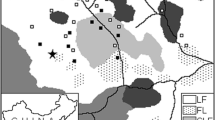Summary
In 1984 a quantitative field study was made on two sympatric species of sundew, Drosera rotundifolia and Drosera intermedia, growing in a small silting-up bog in southern Germany. Both species differ in individual size and abundance but have nearly the same total biomass. Their association along a transect was strongly negative and also the vertical distribution was quite different. D. rotundifolia grows in significantly higher parts of the bog than D. intermedia. The composition of arthropod prey fauna proved to be markedly different in both species. For instance, Collembola were found more frequently on D. rotundifolia, winged insects on D. intermedia. The reasons for these differences are probably different microhabitats and different shapes of the plants. Seasonal dynamics of the arthropod populations affect their share in the composition of prey.
Similar content being viewed by others
References
Büsgen M (1883) Die Bedeutung des Insektenfangs für Drosera rotundifolia. Bot Zeitung 41:569–577
Chandler GE, Anderson JW (1975) Studies on the origin of some hydrolytic enzymes associated with the leaves and tentacles of Drosera species and their role in heterotrophic nutrition. New Phytol 75:51–62
Chandler GE, Anderson JW (1976) Studies on the nutrition and growth of Drosera species with reference to the carnivorous habit. New Phyt 76:129–141
Chauvin R (1967) Die Welt der Insekten. Kindler, München
China W (1953) Two new species of the genus Cyrtopeltis (Hemiptera) associated with sundews in Western Australia. West Aust Nat 4:1–9
Darwin F (1878) The nutrition of Drosera rotundifolia. Linnean Society's Journal — Botany 17:17–32
Dixon KW, Pate JS (1978) Phenology, morphology and reproductive biology of the tuberous sundew, D. erythrorhiza Lindl. Aust J Bot 26:441–459
Dixon KW, Pate JS, Bailey WJ (1980) Nitrogen nutrition of the tuberous sundew, Drosera erythrorhiza, with special reference to catch of arthropod fauna by its glandular leaves. Aust J Bot 28:283–297
Ellenberg H (1974) Zeigerwerte der Gefäßpflanzen Mitteleuropas. Scripta geobotanica IX/9:5–97
Hegi G (1935) Illustrierte Flora von Mitteleuropa. Lehmanns, München
Kaule G (1974) Die Übergangs und Hochmoore Süddeutschlands und der Vogesen. Cramer, Lehre
Kellermann C, Raumer E (1878) Vegetationsversuche an Drosera rotundifolia mit und ohne Fleischfütterung. Bot Zeitung 36:209–218
Knuth P (1898) Handbuch der Blütenbiologie II/1 W. Engelmann, Leipzig
Lloyd FE (1942) The carnivorous plants. Chronica botanica, Waltham, Mass. USA
Oberdorfer E (1962) Pflanzensoziologische Exkursionsflora für Süddeutschland und die angrenzenden Gebiete. Ulmer, Stuttgart
Oberdorfer E (1977) Süddeutsche Pflanzengesellschaften. Fischer, Stuttgart, New York
Pate JS, Dixon KW (1978) Mineral nutrition of Drosera erythrorhiza with special reference to its tuberous habit. Aust J Bot 26:455–464
Paul A, Lutz J (1941) Zur soziologisch-ökologischen Charakterisierung von Zwischenmooren. Ber Bay Bot Ges 25:1–28
Schmeil-Fitschen (1976) Flora von Deutschland und seinen angrenzenden Gebieten. Quelle & Meyer, Heidelberg
Tutin TG (1964) Flora Europaea. Univ Press, Cambridge
Watson AP, Mathiessen JN, Springett BP (1982) Arthropod associates and macronutrient status of the red ink sundew (Drosera erythrorhiza). Aust J Ecol 7:13–22
Wolny E (1897) Die Zersetzung der organischen Stoffe und die Humusbildung. C. Winter, Heidelberg
Author information
Authors and Affiliations
Rights and permissions
About this article
Cite this article
Thum, M. Segregation of habitat and prey in two sympatric carnivorous plant species, Drosera rotundifolia and Drosera intermedia . Oecologia 70, 601–605 (1986). https://doi.org/10.1007/BF00379912
Received:
Issue Date:
DOI: https://doi.org/10.1007/BF00379912




